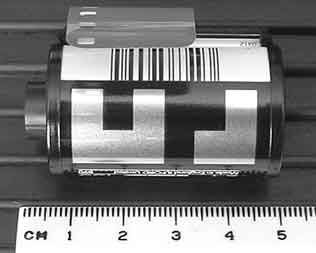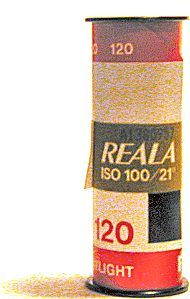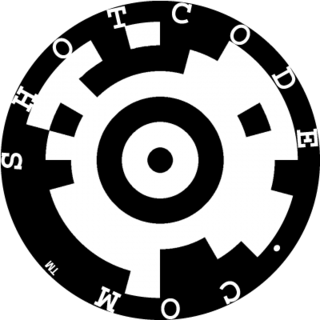
A barcode or bar code is a method of representing data in a visual, machine-readable form. Initially, barcodes represented data by varying the widths, spacings and sizes of parallel lines. These barcodes, now commonly referred to as linear or one-dimensional (1D), can be scanned by special optical scanners, called barcode readers, of which there are several types.

DX encoding is an ANSI and I3A standard, originally introduced by Kodak in March 1983, for marking 135 and APS photographic film and film cartridges. It consists of several parts, a latent image DX film edge barcode on the film below the sprocket holes, a code on the cartridge used by automatic cameras, and a barcode on the cartridge read by photo-finishing machines.

Roll film or rollfilm is any type of spool-wound photographic film protected from white light exposure by a paper backing. The term originated in contrast to sheet film. Confusingly, roll film was originally often referred to as "cartridge" film because of its resemblance to a shotgun cartridge.

Photographic plates preceded photographic film as a capture medium in photography. The light-sensitive emulsion of silver salts was coated on a glass plate, typically thinner than common window glass. They were heavily used in the late 19th century and declined through the 20th. They were still used in some communities until the late 20th century.

The Vatican Apostolic Archive, formerly known as the Vatican Secret Archive, is the central repository in the Vatican City of all acts promulgated by the Holy See.

A QR code is a type of two-dimensional matrix barcode, invented in 1994, by Japanese company Denso Wave for labelling automobile parts. It features black squares on a white background with fiducial markers, readable by imaging devices like cameras, and processed using Reed–Solomon error correction until the image can be appropriately interpreted. The required data are then extracted from patterns that are present in both the horizontal and the vertical components of the QR image.
A silver halide is one of the chemical compounds that can form between the element silver (Ag) and one of the halogens. In particular, bromine (Br), chlorine (Cl), iodine (I) and fluorine (F) may each combine with silver to produce silver bromide (AgBr), silver chloride (AgCl), silver iodide (AgI), and four forms of silver fluoride, respectively.

Digital cinematography is the process of capturing (recording) a motion picture using digital image sensors rather than through film stock. As digital technology has improved in recent years, this practice has become dominant. Since the 2000s, most movies across the world have been captured as well as distributed digitally.
Preservation of documents, pictures, recordings, digital content, etc., is a major aspect of archival science. It is also an important consideration for people who are creating time capsules, family history, historical documents, scrapbooks and family trees. Common storage media are not permanent, and there are few reliable methods of preserving documents and pictures for the future.
Core Data is an object graph and persistence framework provided by Apple in the macOS and iOS operating systems. It was introduced in Mac OS X 10.4 Tiger and iOS with iPhone SDK 3.0. It allows data organized by the relational entity–attribute model to be serialized into XML, binary, or SQLite stores. The data can be manipulated using higher level objects representing entities and their relationships. Core Data manages the serialized version, providing object lifecycle and object graph management, including persistence. Core Data interfaces directly with SQLite, insulating the developer from the underlying SQL.

A microform is a scaled-down reproduction of a document, typically either photographic film or paper, made for the purposes of transmission, storage, reading, and printing. Microform images are commonly reduced to about 4% or 1⁄25 of the original document size. For special purposes, greater optical reductions may be used.

GS1 is a not-for-profit, international organization developing and maintaining its own standards for barcodes and the corresponding issue company prefixes. The best known of these standards is the barcode, a symbol printed on products that can be scanned electronically.
A camera raw image file contains unprocessed or minimally processed data from the image sensor of either a digital camera, a motion picture film scanner, or other image scanner. Raw files are so named because they are not yet processed, and contain large amounts of potentially redundant data. Normally, the image is processed by a raw converter, in a wide-gamut internal color space where precise adjustments can be made before conversion to a viewable file format such as JPEG or PNG for storage, printing, or further manipulation. There are dozens of raw formats in use by different manufacturers of digital image capture equipment.

ShotCode is a circular barcode created by High Energy Magic of Cambridge University. It uses a dartboard-like circle, with a bullseye in the centre and datacircles surrounding it. The technology reads databits from the datacircles by measuring the angle and distance from the bullseye for each point.
Barcode technology in healthcare is the use of optical machine-readable representation of data in a hospital or healthcare setting.
JSON Web Token is a proposed Internet standard for creating data with optional signature and/or optional encryption whose payload holds JSON that asserts some number of claims. The tokens are signed either using a private secret or a public/private key.
The conservation and restoration of film is the physical care and treatment of film-based materials. These include photographic film and motion picture film stock.
The Arctic World Archive (AWA) is a facility for data preservation, located in the Svalbard archipelago on the island of Spitsbergen, Norway, not far from the Svalbard Global Seed Vault. It contains data of historical and cultural interest from several countries, as well as all of American multinational company GitHub's open source code, in a deeply buried steel vault, with the data storage medium expected to last for 500 to 1,000 years. It is run as a profit-making business by private company Piql and the state-owned coal-mining company Store Norske Spitsbergen Kulkompani (SNSK).
Barcode library or Barcode SDK is a software library that can be used to add barcode features to desktop, web, mobile or embedded applications. Barcode library presents sets of subroutines or objects which allow to create barcode images and put them on surfaces or recognize machine-encoded text / data from scanned or captured by camera images with embedded barcodes. The library can support two modes: generation and recognition mode, some libraries support barcode reading and writing in the same way, but some libraries support only one mode.















